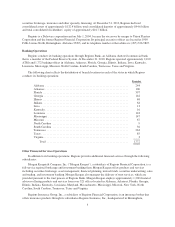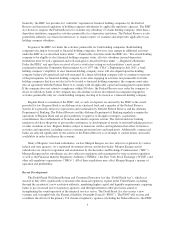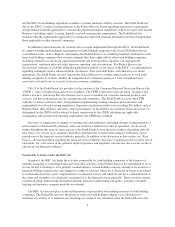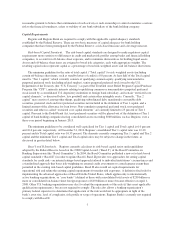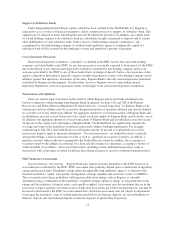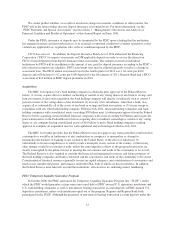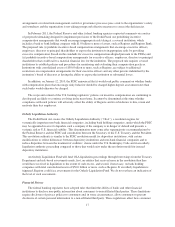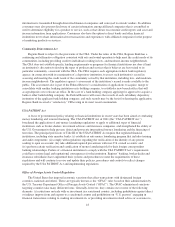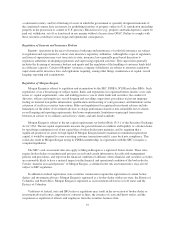Regions Bank 2010 Annual Report Download - page 24
Download and view the complete annual report
Please find page 24 of the 2010 Regions Bank annual report below. You can navigate through the pages in the report by either clicking on the pages listed below, or by using the keyword search tool below to find specific information within the annual report.
securities and other sovereign debt as a component of assets and increase the use of long-term debt as a funding
source. The LCR would be implemented subject to an observation period beginning in 2011, but would not be
introduced as a requirement until January 1, 2015, and the NSFR would not be introduced as a requirement until
January 1, 2018. These new standards are subject to further rulemaking and their terms may well change before
implementation.
Capital Requirements of Regions Bank. Regions Bank is subject to substantially similar capital
requirements as those applicable to Regions. As of December 31, 2010, Regions Bank was in compliance with
applicable minimum capital requirements. Neither Regions nor Regions Bank has been advised by any federal
banking agency of any specific minimum capital ratio requirement applicable to it as of December 31, 2010.
Failure to meet capital guidelines could subject a bank to a variety of enforcement remedies, including the
termination of deposit insurance by the FDIC, and to certain restrictions on its business. See “—Regulatory
Remedies under the FDIA” below.
Given that the Basel III rules are subject to change and the scope and content of capital regulations that U.S.
federal banking agencies may adopt under the Dodd-Frank Act is uncertain, we cannot be certain of the impact
new capital regulations will have on our capital ratios.
Safety and Soundness Standards
Guidelines adopted by the federal bank regulatory agencies pursuant to the Federal Deposit Insurance Act,
as amended (the “FDIA”), establish general standards relating to internal controls and information systems,
internal audit systems, loan documentation, credit underwriting, interest rate exposure, asset growth and
compensation, fees and benefits. In general, these guidelines require, among other things, appropriate systems
and practices to identify and manage the risk and exposures specified in the guidelines. Additionally, the
agencies adopted regulations that authorize, but do not require, an agency to order an institution that has been
given notice by an agency that it is not satisfying any of such safety and soundness standards to submit a
compliance plan. If, after being so notified, an institution fails to submit an acceptable compliance plan or fails in
any material respect to implement an acceptable compliance plan, the agency must issue an order directing action
to correct the deficiency and may issue an order directing other actions of the types to which an undercapitalized
institution is subject under the “prompt corrective action” provisions of the FDIA. See “—Regulatory Remedies
under the FDIA” below. If an institution fails to comply with such an order, the agency may seek to enforce such
order in judicial proceedings and to impose civil money penalties.
Regulatory Remedies under the FDIA
The FDIA establishes a system of regulatory remedies to resolve the problems of undercapitalized
institutions. The federal banking regulators have established five capital categories (“well-capitalized,”
“adequately capitalized,” “undercapitalized,” “significantly undercapitalized” and “critically undercapitalized”)
and must take certain mandatory supervisory actions, and are authorized to take other discretionary actions, with
respect to institutions which are undercapitalized, significantly undercapitalized or critically undercapitalized.
The severity of these mandatory and discretion supervisory actions depend upon the capital category in which the
institution is placed. Generally, subject to a narrow exception, the FDIA requires the banking regulator to appoint
a receiver or conservator for an institution that is critically undercapitalized. The federal bank regulatory agencies
have specified by regulation the relevant capital levels for each category:
“Well-Capitalized” “Adequately Capitalized”
Leverage ratio of 5 percent,
Tier 1 capital ratio of 6 percent,
Total capital ratio of 10 percent, and
Not subject to a written agreement, order, capital
directive or regulatory remedy directive requiring a
specific capital level.
Leverage ratio of 4 percent,
Tier 1 capital ratio of 4 percent, and
Total capital ratio of 8 percent.
10





